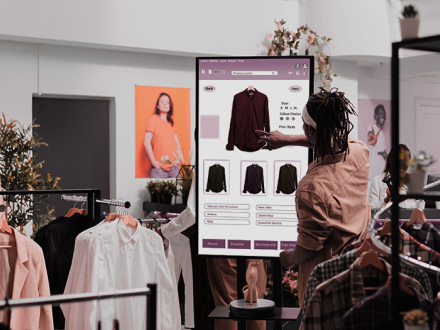Your message has been sent.
We’ll process your request and contact you back as soon as possible.
The form has been successfully submitted.
Please find further information in your mailbox.


Digital transformation in retail has made online and brick-and-mortar stores as convenient as ever. Thanks to advanced technology, shoppers can easily access thousands of products to browse through, choose custom options, place orders, and pay with zero friction.
On the other hand, the sellers get the tools to manage their stocks conveniently, communicate with suppliers, keep track of their customers’ orders, and even collect and analyze data to improve the shopping experience further.
But it doesn’t end just there. There are many things that data insights and sophisticated hardware can improve retail. Let’s discuss how digital transformation in retail reinvents experience for all actors involved – from suppliers to end customers.
The demand for various products is often unstable, making it difficult for retailers to balance their supply volumes. They have to consider a lot of things to keep the stocks sufficient, like anticipated demand for certain goods, current stock levels, costs, supplier production capacity, and so on.
Digital transformation in the retail industry offers access to advanced inventory management technology that makes stocking up on goods more efficient with informed and automated decision-making. With the hardware collecting relevant data, the software offers ways to optimize supply chain management.
Supported by inventory management hardware and software, data analytics services track stock levels and help avoid understocking and overstocking situations. Overstocking can lead to inventory obsolescence, which means the product becomes irrelevant when it eventually hits the store shelves. On the other hand, understocking results in lost sales opportunities because of the retailer’s inability to keep up with demand.
Managing inventory is no easy feat. It is necessary to balance the stocks so that retailers’ shelves are never empty and the goods do not spend too much time in the warehouse. Keeping track of inventory and storage becomes increasingly difficult as the company and production rates grow, and it is a matter of time before the whole system becomes incomprehensible.
That is where digital transformation for retail sets things in order. There are many tools available to assist retailers in maintaining adequate stock levels to satisfy customer needs.
AI allows retailers to analyze the data collected from various sources and use it to make decisions regarding stocking up on goods. It can analyze the data from cameras and sensors installed in the store and determine how much of a particular product customers buy. Then, the retailer can use that data to adjust the order volume from the supplier.
Embedded devices powered by computer vision tech scan the area and detect the objects within. They recognize different goods on the shelves, assess the stock volume, and make ordering decisions. This way, the retailers can optimize their operational costs by not overstocking the products and increasing the volume of those in high demand.
RFID tags improve inventory management with convenient scanning and better object tracking across the inventory management system. Because the RFID scanners do not require a clear line of sight to scan RFID tags, the inventory management system will have a much easier time keeping track of the goods in the warehouse.
The RFID scanners located in the warehouse allow the system to get more frequent updates on the goods’ availability or their exact location. The staff uses mobile RFID scanners during delivery to facilitate inventory check-in and shipment verification.
Barcodes, on the other hand, have to be visible to be scanned. At the same time, they share a significant part of RFID functionality tags at a lower cost and may be preferable in some situations. For instance, RFID tags can have trouble transmitting data through materials like metal or liquids. Also, RFID tags require dedicated scanners, while barcodes can be scanned with a smartphone camera through a dedicated application. In case the scanner fails, employees can use smartphones issued by the employer.
Digital transformation in the retail sector can improve the customer experience and remove friction from shopping. Let’s take a look at what tools are at play here.
Smart shelves help stores keep the most desired goods on the shelves at all times. Equipped with Computer Vision sensors, the shelves can track the availability of certain goods and report the dwindling stock to the warehouse managers. From there, the warehouse management system uses the data to arrange additional deliveries and adjust order volumes, increasing or decreasing the amount of goods accordingly.
The digital transformation for retail also enables stores to offer the freshest goods. The stores that sell the food they make themselves can adjust the volume of things they prepare based on demand. For example, smart shelves track how much in-store baked bread people buy and notify the bakers if the stock runs too low.
Self-checkout kiosks and contactless payments significantly reduce customers’ time in lines, allowing retailers to benefit from increased foot traffic and sales volume. Since customers prefer to shop at stores where they can quickly get in, pay, and get out, self-service is a must for retailers to stay competitive for customers’ preferences.
Using a self-checkout kiosk, customers scan the barcodes of the goods they buy, get the amount they owe, and pay with a contactless payment terminal attached to the kiosk.
They are pretty compact compared to regular checkout, which means by installing several kiosks in the store, the retailer further reduces purchase processing time.
Interactive kiosks provide the customers with relevant information, helping them along their journey. For instance, kiosks installed in shopping malls feature interactive maps to help customers find their way to a particular store or entertainment spot. They also list all locations present at the mall and other information like parking and working hours.
An array of smart sensors tracking customer behavior helps retailers tweak their offerings and customize experiences to attract more clientele.
Customer behavior details the way customers act along their purchase journey, including the time they come into the store, the section they spend the most time in, the products they look at and purchase, and any other things that help retailers find ways to improve the shoppers’ experience.
For instance, Wi-Fi fingerprinting, LED lighting frequency tracking, and smartphone microelectromechanical systems track customers’ location as they wander around the store. This way, the retailers can see what sections customers spend more time in and change the layout to optimize the shoppers’ journey and push the favored products.
Tracking the exact time of day the customers come to the store is another strong benefit of digital transformation in retail – having that information, the store managers may open more checkout points and deploy additional sales floor attendants to handle the fluctuating traffic.
In addition, Bluetooth tech can be used to send loyalty programs or discount offers to nearby shoppers. A person passing by the store can get an ad that may catch their interest at the right moment.
Sensors powered by computer vision tech also track queues to find the bottlenecks in the customer journey. 1 of every 3 customers will likely leave the store if they have to wait more than 5 minutes to pay for their purchase – retailers can minimize lost sales opportunities by using the queue data to adjust the location’s operational capacity to match the traffic volume.
The other advantage is reduced adoption costs compared to other smart store options: for example, stores with just-walk-out tech require an array of cameras and sensors to track customers and the items they put into the baskets. Alternatively, deploying smart carts is just about purchasing the carts and educating the staff and the shoppers on how to use them.
In addition, retailers benefit from displays built into the smart shopping carts. For instance, as a customer picks and scans his items, the display takes that information and offers adjacent goods: if it sees a person picking up some ships, it may suggest some dips.
In today’s competitive retail environment, it is more important than ever for commerce companies to embrace retail digital transformation. By implementing advanced tools, retailers can set themselves up for success in the years to come.
A combination of hardware and software solutions can streamline the entire experience for suppliers, retailers, and shoppers. Suppliers can use embedded hardware and data analytics to predict demand, manage inventory, and augment deliveries effectively.
Retailers can track customer behavior to determine the most desired goods and adjust their order information accordingly. With the information from smart shelves and various sensors, they can ensure their stores always offer a sufficient volume of products.
On the other end, the customers benefit from quick deliveries, sufficient stock of goods, and personalized experiences.
Digital transformation is crucial for retailers because it enables them to adapt to rapidly changing consumer behaviors and market trends. By integrating advanced technologies, retailers can improve customer experiences, streamline operations, and enhance decision-making through data analytics. This transformation also allows for greater online presence and e-commerce capabilities, meeting the growing preference for online shopping. Additionally, digital tools help retailers optimize inventory management, personalize marketing efforts, and improve overall efficiency, leading to increased competitiveness and profitability in a digital-first economy.
Key components of retail digital transformation involve integrating e-commerce platforms for online sales, utilizing data analytics for consumer insights, employing digital marketing for personalized experiences, and adopting mobile technologies for convenience. It also includes implementing omnichannel strategies to unify online and offline interactions, optimizing supply chains with digital tools, leveraging cloud computing for IT flexibility, and ensuring robust cybersecurity to safeguard data and digital assets.
Digital transformation enriches customer experience through personalized product selection and recommendations, streamlined payment and delivery options, efficient support, convenient online shopping, and improved logistics.
Start with assessing the daily operations and identifying challenges. Then, create a clear plan of what technology you need to implement to solve your challenges, like building a website, a mobile app, or adopting software to handle your inventory or customers’ data.
Future digital transformation trends for retailers include artificial intelligence for personalized experiences, augmented and virtual reality in shopping, sustainability in e-commerce, the internet of things for operational efficiency, advanced data analytics, voice commerce, integrated omnichannel strategies, and blockchain for secure transactions.
Rate this article:
4.8/5 (45 reviews)












Your message has been sent.
We’ll process your request and contact you back as soon as possible.

By signing up you agree to our Privacy Policy, including the use of cookies and transfer of your personal information.